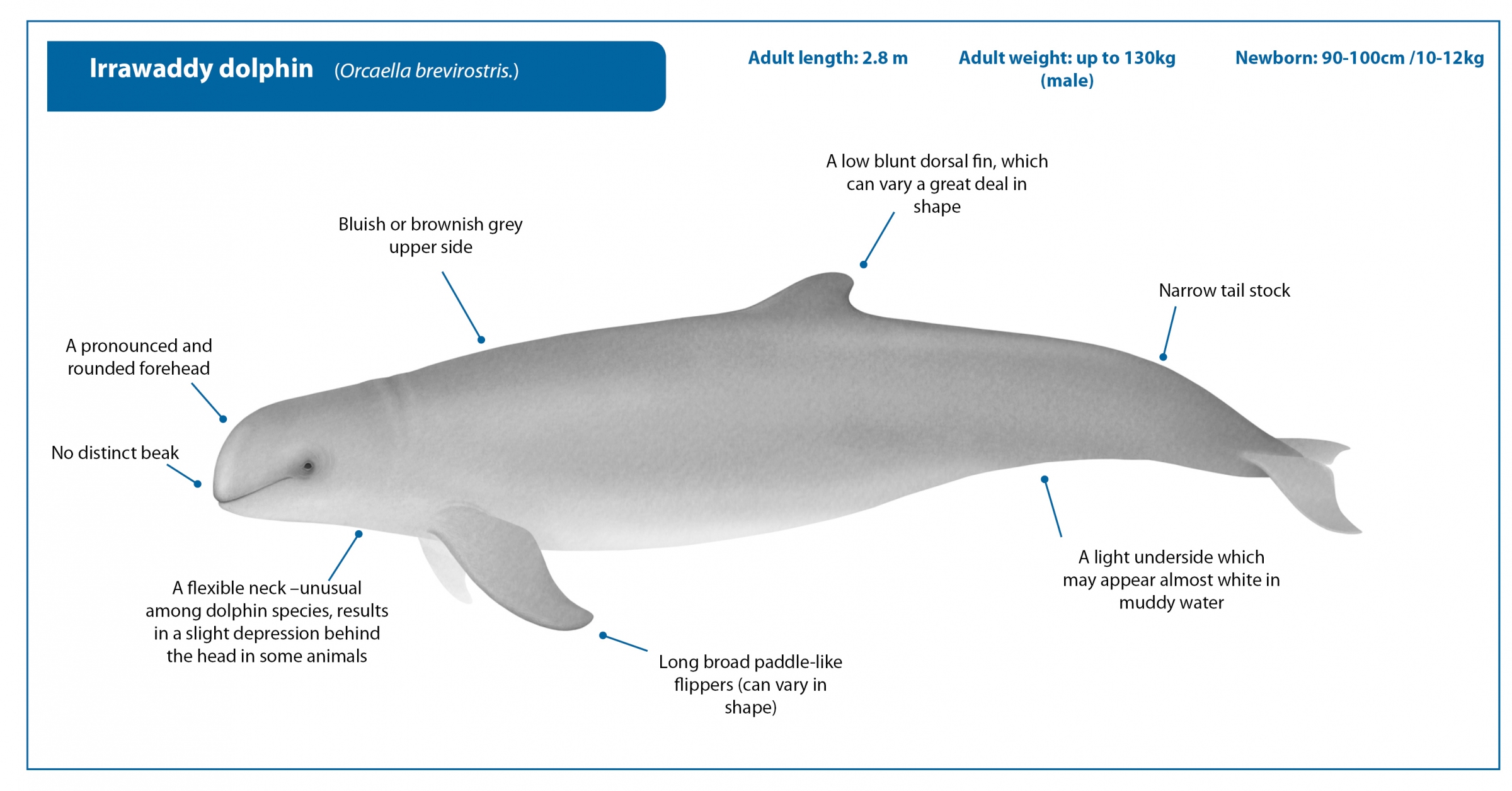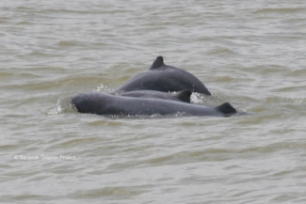Irrawaddy dolphins are not known to be particularly acrobatic or showy, but their history of close associations with fishing boats makes them approachable for dolphin watching in some areas of Southeast Asia where they are considered the main focus of marine tourism. Their preference for nearshore habitats associated with freshwater inputs keeps them resident in fairly restricted geographical areas, and therefore makes them easier to locate than some species that have wider ranging habits. But this habitat restriction also places them at great risk from human-induced threats like entanglement in fishing gear, habitat changes from coastal construction, pollution, and disturbance from vessel traffic1.

References
Show / Hide References
- Smith, B. D. in Encyclopedia of Marine Mammals Vol. Third Edition (eds B Würsig, J.G.M. Thewissen, & K.M. Kovacs) (Academic Press, Elsevier, 2017 (in press)).
- Beasley, I., Robertson, K. M. & Arnold, P. W. Description of a new dolphin, the Australian Snubfin Dolphin Orcaella heinsohni sp. n. (Cetacea, Delphinidae). Marine Mammal Science 21, 365-400 (2005).
- Beasley, I. et al. in Humpback Dolphins (Sousa spp.): Current Status and Conservation, Part 2: Advances in Marine Biology Vol. 73 (eds T. A. Jefferson & B. E. Curry) pp. 219-272 (Elsevier, 2016).
- Minton, G., Peter, C. & Tuen, A. A. Distribution of small cetaceans in the nearshore waters of Sarawak, East Malaysia. The Raffles Bulletin of Zoology 59, 91-100 (2011).
- Peter, C. et al. Artisanal fisheries and cetaceans in Kuching Bay, Sarawak, East Malaysia: Threats and potential mitigation. Report presented to the meeting of the Scientific Committee of the International Whaling Commission SC/66b/SM09, 18 (2016).
- Smith, B. D. et al. Status, ecology and conservation of Irrawaddy dolphins(Orcaella brevirostris) in Malampaya Sound, Palawan, Philippines. Journal of cetacean research and management 6, 41-52 (2004).
- Smith, B. D., Braulik, G., Ahmed, B. & Mansur, R. Abundance of Irrawaddy dolphins (Orcaella brevirostris) and Ganges River dolphins (Platanista gangetica gangetica) estimated using concurrent counts made by independent teams in waterways of the Sundarbans mangrove forest in Bangladesh. Marine Mamal Science 22, 527-547 (2006).
- Smith, B. D. et al. Habitat selection of freshwater-dependent cetaceans and the potential effects of declining freshwater flows and sea-level rise in waterways of the Sundarbans mangrove forest, Bangladesh. Aquatic Conservation: Marine and Freshwater Ecosystems 19, 209-225 (2009).
- Smith, B. D., Diyan, A. A., Mansur, R. M., Mansur, E. F. & Ahmed, B. Identification and channel characteristics of cetacean hotspots in waterways of the eastern Sundarbans mangrove forest, Bangladesh. Oryx 44, 241–247 (2010).
- Peter, C., Poh, A. N. Z., Ngeian, J., Tuen, A. A. & Minton, G. in Naturalists, Explorers and Field Scientists in South-East Asia and Australasia (eds I. Das & A.A. Tuen) 225-238 (Springer, 2016).
- Smith, B. D. Irrawaddy dolphin, Orcaella brevirostris in Encyclopedia of Marine Mammals (eds W. Perrin, B. Wursig, & J.G.M. Thewissen) 638-642 (Elsevier, 2009).
- Ponnampalam, L. et al. Behavioral Observations of Coastal Irrawaddy Dolphins (Orcaella brevirostris) in Trat Province, Eastern Gulf of Thailand. Aquatic Mammals 39, 401-408 (2013).
- Khan, M. et al. Shark attacks on Irrawaddy dolphin in Chilika lagoon, India. Journal of the Marine biological Association India 53, 27-34 (2011).
- Smith, B. D. Conservation Status of the Irrawaddy Dolphin (Orcaella brevirostris). Report No. CMS/ScC14/Doc.8, 1-16 (Convention on the Conservation of Migratory Species of Wild Animals, Bonn, Germany, 2007).
- Smith, B. D., Ahmed, B., Mowgli, R. B. & Strindberg, S. Species occurrence and distributional ecology of nearshore cetaceans in the Bay of Bengal, Bangladesh, with abundance estimates for Irrawaddy dolphins Orcaella brevirostris and finless porpoises Neophocaena phocaenoides. Journal of Cetacean Research and Management 10, 45–58 (2008).
- Van Bressem, M. F. et al. Cutaneous nodules in Irrawaddy dolphins: an emerging disease in vulnerable populations. Diseases of Aquatic Organisms 107, 181-189, doi:10.3354/dao02689 (2014).
- Minton, A. G. et al. Orcaella brevirostris in The IUCN Red List of Threatened Species 2017 (e.T15419A50367860. Downloaded on 10 December 2017., 2017).
- IWC. Report of the Scientific Committee: Annex M: Report of the Sub-Committee on Small Cetaceans. 47 (International Whaling Commission, Bled, 2016).
- Reeves, R. R. et al. Assessment of Mortality of Irrawaddy dolphins in the Mekong River and recommendations for a population recovery plan. 14 (IUCN, 2009).
- Sutaria, D. Species conservation in a complex socio-ecological system: Irrawaddy dolphins, Orcaella brevirostris in Chilika Lagoon, India, James Cook University, (2009).
- Mustika, P. L. K. et al. A rapid assessment of wildlife tourism risk posed to cetaceans in Asia. Journal of Sustainable Tourism, 1747-7646, doi:10.1080/09669582.2016.1257012 (2016).



